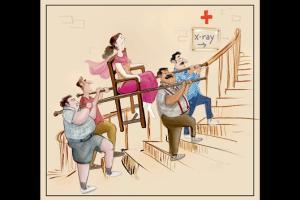Having injured her foot on an annual trip to India, a Sydney-based journalist recounts the difficult journey from Sunderbans to Jaipur made possible by the ingenuity of a few people

Illustration/Surabhi Dhandia
A Cancelled flight, a lost suitcase, a stolen wallet are exigencies we may plan for while travelling, but I had never considered the possibility of an unexpected injury, until it happened during one of my annual sojourns in India. It revealed the dichotomy between the avant-garde and primitive modes of transport and healthcare facilities that exist in the country.
ADVERTISEMENT
From riding on a vegetable cart to being carried in a no-frills palanquin-like wooden chair for an x-ray, I used myriad modes of transport from Sunderban in the east to Jaipur in the west, following a foot injury.
I snapped the critical weight-bearing bone (the talus) in the foot while alighting from a small, rocking wooden boat on to the hard, concrete surface of a jetty. A torrent of excruciating pain overwhelmed my senses. I have faint recollection of removing the calliper that had shielded the rest of the polio-affected limb from injury and being carried to a bunk in the underdeck of our boat. The first-aid kit on the boat was ill-equipped - with only a near-empty can of an anti-inflammatory spray, my pain threshold was being tested to its limits.
Cushioned amidst cauliflowers
We were in Dobanki, an island in the remote mangrove forests of the Sunderban Tiger Reserve in West Bengal. The nearest pharmacy was six hours away on Gosaba island, close to the Gothkali ferry jetty, where our taxi to Kolkata was parked.
The receding tide had exposed the flight of steps leading to the top of the Gothkali jetty. Even as I contemplated options of how I would make it to the top, the boatman and his deckhand had me seated on a plastic chair, confident that they would be able to safely carry me up the steps.
My heart was in my mouth as the two men lifted the chair up, possibly using all the strength their lean bodies could muster, and carefully balanced their front foot on the narrow staircase, made slippery by the perennial flow of brackish water. I was then transferred to a vegetable cart, gently cushioned between cauliflowers and aubergines, and wheeled to the taxi. The vegetable seller, aided by the many village children who had followed their parents to watch this spectacle unfold, used all his might to push the cart through the slushy slope leading to the tar road. It was a relief to be shielded amidst the vegetables after the dangling chair ride.
Watching my pain reflected in the eyes of the villagers, who were trying everything within their means to make this transition as smooth as possible, was indeed heartening.
The ingenuity of Indians to find a solution within the available means, safety and risk issues aside, never ceases to amaze me. I gently cradled my foot in my palms, as we drove to Kolkata in an SUV on rough roads, snaking through a procession and chaotic traffic.
Airport transfer challenges
I was in a swarm of nearly 100 patients at the radiology clinic in Kolkata. The x-ray room was on the second floor of a heritage building with no elevators. Every patient, unable to walk, was carried in an improvised wooden chair with poles, borne on the shoulders of four men. My knuckles turned white as we made the precarious ascent on the winding staircase. In sharp contrast to the rudimentary access, the machinery upstairs was cutting edge. The diagnosis ruled out a fracture, so we strapped the foot in a crepe bandage and continued on our planned journey.
At Kolkata airport, a hydraulic hoist attached to a mini truck lifted wheelchair users to the aircraft door. But in the absence of cabin wheelchairs, playing hopscotch on one leg to reach my seat was painfully amusing.
We landed in icy fog at the Lal Bahadur Shastri airport in Varanasi (Uttar Pradesh). The descent from the vertical staircase to the tarmac was on a modified wheelchair, carried by two men clinching the aluminium rods protruding on either side of the chair. It was scary to say the least and my hands kept reaching out to grasp the handrail.
As India's aviation market expands, aerobridges are still limited. Passengers are mostly ferried to remote parking bays in buses. Wheelchair passengers are then either carried up the stairs by two men or wheeled up by one man pushing and the other pulling the chair up the steep winding ramps that connect the tarmac to the aircraft's cabin door.
We boarded a taxi for our next destination, Allahabad. The driver was compelled to repeatedly veer off on the unsealed road shoulder to make way for trucks, some driving on the wrong side of this busy divided Delhi-Kolkata Highway. The constant braking and jolting magnified the discomfort.
In Allahabad, a young orthopaedic surgeon was kind enough to come to the car to examine the foot. Under a street lamp, he spotted a fracture on the x-ray. With the foot secured in a fibreglass cast, I travelled to my parental home in Jaipur via Delhi, facing more airport transfer challenges, the bizarreness of the predicament wasn't lost on me.
Catch up on all the latest Mumbai news, crime news, current affairs, and also a complete guide on Mumbai from food to things to do and events across the city here. Also download the new mid-day Android and iOS apps to get latest updates
 Subscribe today by clicking the link and stay updated with the latest news!" Click here!
Subscribe today by clicking the link and stay updated with the latest news!" Click here!






